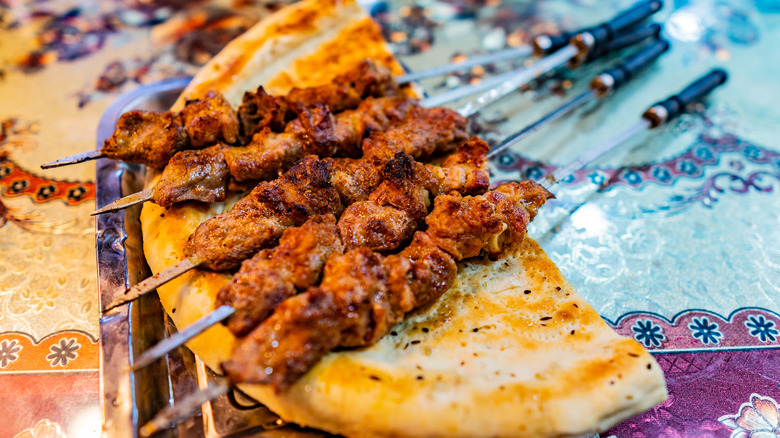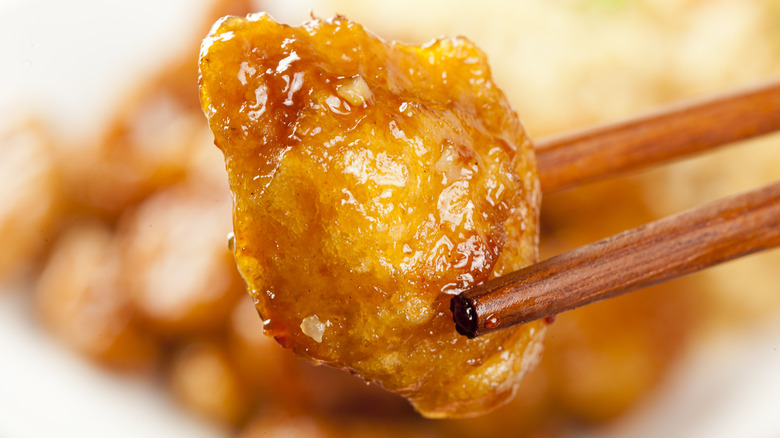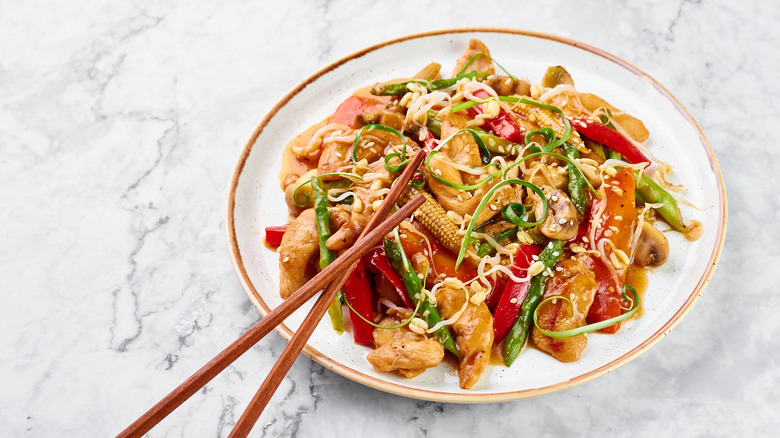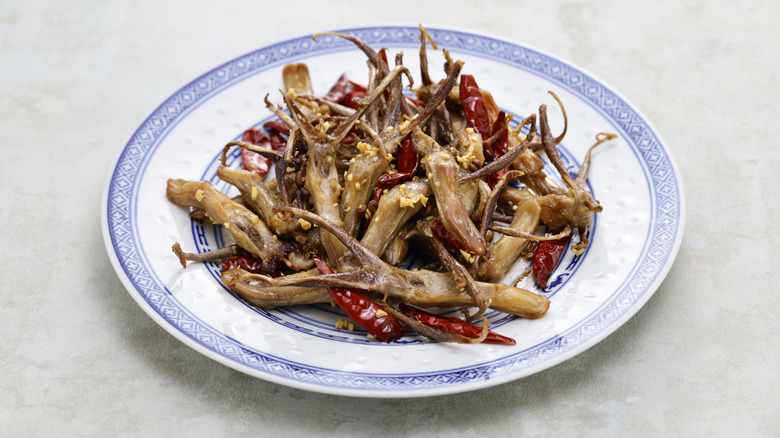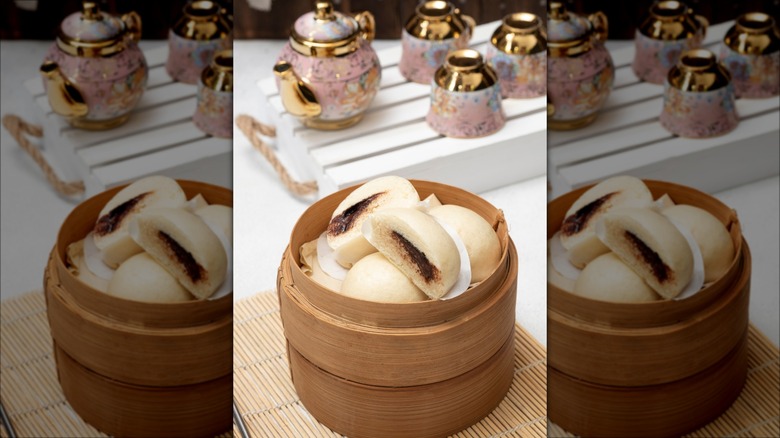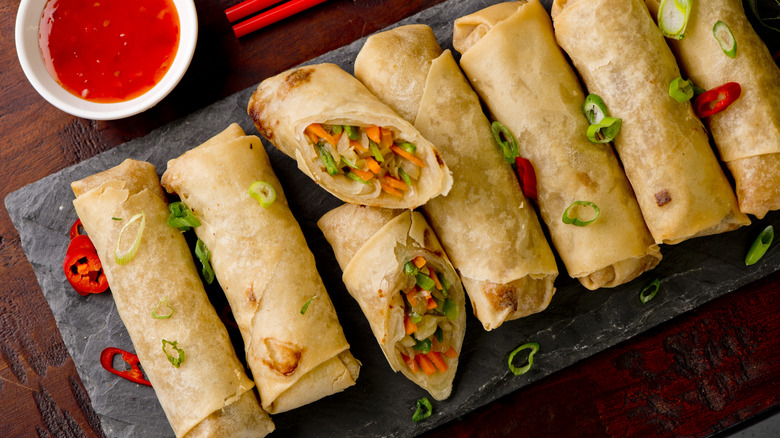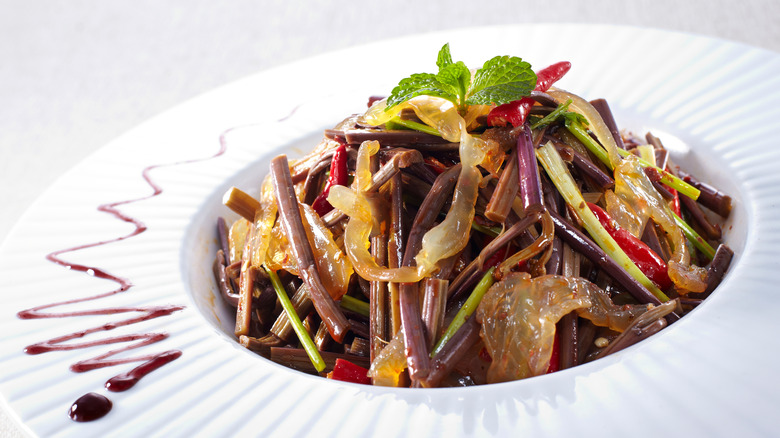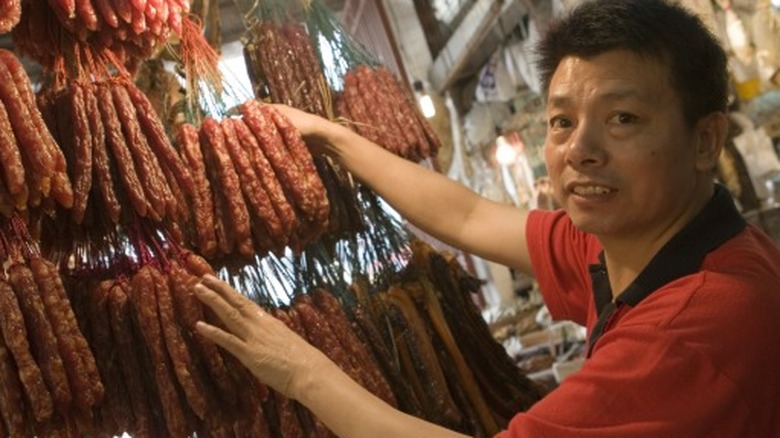This Is Why Chinese Food Tastes Different In America
Chinese food has a long history in America, beginning in earnest during the mid-19th century. Over this time, traditional Chinese dishes have been adapted for a number of reasons including the scarcity of certain ingredients, the public's tastes, and America's changing views on certain types of food. The result of all these changes has been the creation of a distinct, new cuisine, which has been coined American Chinese.
Unfortunately, there are many people who do not view American Chinese as a cuisine. For these people, it is simply an inauthentic representation of traditional Chinese food that tastes starkly different from the 'real' thing. In regards to taste, they're not wrong. American Chinese food does taste different from food that is served across China. This should come as little surprise given that China is home to a multitude of cuisines created by and for an abundance of distinct ethnic groups over thousands of years. Recreating such regional nuances in the United States would be all but impossible. Yet, there are many further reasons why Chinese food in the U.S. is so different. In this article, we explore all of them, revealing why Chinese food tastes so different when it's prepared, served, and eaten in America.
Chinese food in America often overlooks several Chinese cuisines
China is an enormous country that covers nearly a quarter of Asia's land mass. The country is split into 31 provinces, municipalities, and autonomous regions each with its own history and culture. Despite this, many Americans have long viewed China as a country with one culture and, as a consequence, a single cuisine.
This misguided belief has been compounded by the overriding popularity of a few choice Chinese cuisines. The first Chinese cuisine to be popular in the United States was Cantonese. This caused many Americans to conflate Cantonese cuisine with 'Chinese cuisine,' a belief that held until the 1960s when other Chinese cuisines began to break through in the U.S. Today, even those Americans who are aware of China's multiplicity are guilty of familiarizing themselves with one particular cuisine — for example, Sichuan cuisine — at the expense of others. All these processes have led to Chinese food in America being much less multidimensional than it is in China.
A good example of lack comes from China's arid areas. Here, food is influenced by a variety of ethnic groups including Hui Muslims and Uyghurs. The food of these Chinese citizens, including kebabs and rose flavored lotus patties, is rarely incorporated into the menus of Chinese restaurants in the U.S. As such, it is impossible for Chinese food in the U.S. to taste the same as it does in China given that whole cuisines are vastly underrepresented.
It has been adapted to suit American palates
Several dishes from China's various cuisines have become popular in the United States. Nearly all of these have been adapted in some way to suit American palates as restaurant owner Wesley Chen highlighted to Survive + Thrive Boston: "American taste buds are more fond of sweet, sour, salty, bold flavors, and Americans also enjoy solid, crispy texture. The Chinese sense of taste is more compounded. We look for more layers of flavors combined, we also enjoy more soft and gooey texture."
As Chen highlights, American Chinese food is often sweeter than food from China itself. It also tends to be more heavily sauced. Those who criticize American restaurants for making these alterations fail to understand one simple point: all restaurants need to create and serve dishes that will sell in order to survive, and this is the version of Chinese food that sells best in the United States.
It's important to note that American Chinese dishes are in no way lesser than those served in China, they're simply different. Interestingly, this difference extends past taste and includes other aspects of the food as well. A prominent example of this is how American Chinese dishes are generally devoid of small bones. Fish is fileted instead of being served whole and fiddly specialties like chicken feet are often passed over altogether. This stands in direct contrast to food in China where bone-laden dishes are deemed some of the most desirable.
In the past, some ingredients weren't readily available in the U.S.
Chinese American food is by no means new to the United States. In fact, this cuisine has its origins in California's gold rush. During this time, and the decades that followed, many ingredients that were integral to Chinese cooking were not available in the U.S. and Chinese immigrants were forced to substitute ingredients from their home country for popular, readily available ingredients like broccoli.
Like all restaurant owners, these early Chinese Americans needed to turn a profit. This meant producing food that was cost effective and marketable to the American public. So, even when Chinese ingredients began to become available, their prohibitively expensive price prevented many immigrants from cooking with them. Instead of creating heavily substituted versions of traditional dishes, this caused some Chinese American chefs to invent new dishes like chop suey using ingredients that were cheap and popular in the U.S
Today, cooks both home and professional have unrivaled access to ingredients from around the world, including China. Thanks to their ubiquity, what were once specialist ingredients can now be purchased cheaply. Over the 150 years since Chinese people immigrated to the U.S., American Chinese dishes like chop suey have become embedded in the local food culture. So integral are these that they cannot be replaced, even by Chinese dishes that claim a greater degree of authenticity.
Generally, Americans do not prize offal
Offal and other associated cuts of meat are a prized part of China's many cuisines. This not only stems from the global tradition of avoiding waste but also the many medicinal properties that these parts of the animal are thought to have. What's more, cuts that many modern Americans would shun like heads, feet, and tongues are deemed among the most extravagant and desirable in Chinese culture and it is considered a mark of respect to be served them.
Generally speaking, Americans do not value offal as the Chinese do. Instead, the majority of the American populace avoid cooking with it or eating offal altogether. This is due to several reasons including not knowing how to cook with offal and the cuts' associations with poverty.
The lack of an American appetite for offal means a vast array of traditional Chinese dishes are rarely reproduced in the United States. These include the likes of duck tongue, Shanghainese braised intestines, and blood tofu. Many Americans prefer to eat foods they are more comfortable with as restaurant manager Jennifer Li highlighted to Survive + Thrive Boston: "American clients like julienne pork or chicken because it is easy to eat, and they will never order intestine and blood pudding." The shunning of offal invariably affects the taste and availability of certain Chinese foods in the U.S.
Many Americans have fixed ideas about certain ingredients
Dessert is a much smaller part of China's cuisine than it is in the United States. In fact, most Chinese meals eschew dessert altogether, finishing on a savory course or with some fresh fruit. When sweet dishes are made in China, they are often created by sweetening what many Americans see as exclusively savory ingredients. A prominent example of this is adzuki beans which are often sweetened with sugar before featuring in dishes like red bean buns.
Restaurant manager Julie Feng highlighted how China's penchant for sweetening savory ingredients can put off some Americans when interviewed by Survive + Thrive Boston: "Americans have an image that beans are supposed to be salty instead of sweet, so they are not willing to try our traditional Eight Treasure Ice with Beans."
Due to resistance over familiar ingredients being used in unfamiliar ways, many cooks working in the U.S. do not employ ingredients in the same way they would if working in China. This is another reason why Chinese foods in the U.S. tastes so different to similar dishes served in China.
Different cooking methods are more prevalent in America
So far we have focused on how ingredients have been altered during the Americanization of Chinese food. Cooking methods have also undergone the same process with American Chinese restaurants utilizing cooking processes like deep frying with more regularity than restaurants in China.
Chinese restaurants in the United States have adopted this cooking method for several reasons. One is that Americans prefer the crisp textures imparted by deep frying as chef Chris Cosentino explained to Vanity Fair: "We're a culture of texture. Every country has its preferred food texture [...] Our [American] texture is crunchy. We like our potato chips, our tortilla chips, our french fries, our fried chicken."
Another reason for cooking methods like deep frying and stir-frying becoming dominant in American Chinese restaurants is that Americans tend to dine more quickly than Chinese people do. The time pressure associated with swifter dining necessitates the use of quicker cooking methods in the kitchen. This leads Americans away from Chinese dishes and cuisines that employ a range of other, slower cooking methods like hóng shāo, otherwise known as red cooking.
Texture is not as important to some Americans
Much like with tastes, aromas, and preparation methods, different textures are deemed desirable — or not — given a certain population's preferences. We have already seen how Americans prize crisp foods. Another texture that's highly desirable in the United States is creaminess. But, despite these clear textural desires, Americans are known for a lesser appreciation of textures than the Chinese.
In China, texture is one of the most celebrated aspects of food. This is reflected in language; a paper published in the Journal of Texture Studies highlighted that in Chinese languages, there were 317 words used to describe texture. The English language only boasts 77.
Food in China celebrates a huge array of textures from the crisp, flaky ones beloved in the West to gelatinous, bouncy, and slippery textures that Americans find challenging. The difference in textural preferences between the two nations sees some prized Chinese ingredients go unused in the U.S., for example, jellyfish. What's more, the demand for different textures means a huge array of cooking processes are used to prepare food in China. American Chinese food, on the other hand, often utilizes the same few processes.
In short, an underappreciation of texture prevents many Americans from experiencing Chinese food as it is served in China as was highlighted to The Guardian by writer Fuchsia Dunlop: "If you don't like things for their texture, or slithery things like jellyfish, you can't access a whole aspect of Chinese gastronomy."
Traditional Chinese cooking prizes live, flavorful meat
Generally speaking, meat in China is deemed superior if it comes from a muscle — and an animal — that has been well exercised. This meat is naturally tougher and contains more collagen, however, the presence of connective tissue also makes these cuts the most flavorful of the entire animal. In China, this flavorful meat is known as huorou.
The opposite is true for meat in the United States. American consumers have come to prioritize tenderness and ease of eating above flavor. This has resulted in bland meat from unexercised animals and muscle dominating the market, a classic example being battery-farmed chicken breasts. This meat is known as sirou or dead meat.
When Chinese food is cooked in the U.S., huorou is often replaced by sirou. But by substituting a deeply flavorful cut of pork or beef for blander cuts — or in some instances by replacing it with chicken — the dishes instantly taste different. In some respects, they become a shadow of their former selves.
Dining practices are different
The difference between food in China and the United States is not limited to the meal's physical characteristics or attributes. How the food is enjoyed also varies from one country to the other.
In 2021, the Hartman Group estimated that 42% of all U.S. adult meals were taken alone. In contrast, Chinese citizens value eating as a family. A 2019 Statista poll showed that nearly 70% of Chinese citizens viewed eating as a family as very important with only just over 1% strongly disagreeing.
Because they usually dine as a group, the norm in China is for many dishes to be shared amongst all diners. This sees a range of tastes and textures being experienced in quick succession to one another. In the U.S., the opposite is true. Solitary diners usually stick to a single main course. This often remains the case even when American diners eat together. Of course, experiencing one dish in isolation will greatly affect a diner's perception of its taste when compared to enjoying multiple dishes at the same time.
Another way Chinese and American people differ when eating is in which utensils they use. Chinese people often employ the use of chopsticks. Americans, on the other hand, prefer the fork. Restaurant owners in the U.S. have made alterations to cater to this; some chefs shorten their noodles to make them easier to manipulate. This affects how the meal tastes by reducing how much sauce the noodles can carry.

